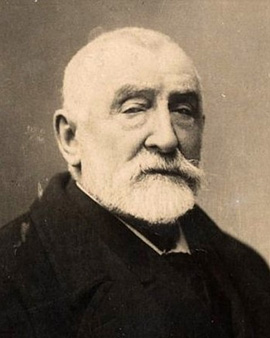Actually Henri Joseph was Harpignies commercial traveller, but then he gave this up and became a traveller in matters of art. Born in Valenciennes in 1819, he did not begin to study art until the age of 29. From the very beginning he had a great enthusiasm for the landscapes of his homeland, but also of the neighbouring countries. Harpignies undertook extensive travels through the Netherlands, Germany and Italy, where he began studying at the Academy of Art in Rome. From there he brought classical views of the Eternal City back to France in 1850. But such city views did not become a main theme.
Instead, everywhere he loved above all bucolic landscapes, autumnal sceneries of the harvest season, isolated farmsteads, groves of trees against a wide horizon bathed in atmospheric light. In his pictures, people can usually be seen, if at all, only quite small in the distance. They carry out their daily farm work or are on their way to their plaice. Sometimes you can see small villages with the towering church tower embedded in the surroundings. No question: Harpignies has seen and studied these landscapes in detail. The pure construction of an ideal landscape was not his thing, but a romantic exaggeration of what he saw was. His work was very much influenced by the school of Barbizon. There, in the forest of Fontainebleau, open-air painting was propagated, the exact study of a not necessarily sensational nature, but rather of quiet corners. Camille Corot was particularly important for Harpignies, with whom he had a friendship. From 1852 the artist maintained a studio in Paris and increasingly convinced the jury of the Paris Salon. In 1860 he travelled with Corot to Italy and from 1863 Harpignies stayed there for another two years, where he produced further works. These paintings, bathed in Mediterranean light, were particularly popular with the public. Italy was to be a special inspiration for his extraordinarily long career: "It was Rome that found me, created me, supported me". But even the Eternal City with the Colosseum seems strangely enraptured in the distance. With the painting "Evening in the Roman Campagna" he celebrated one of his greatest successes: Harpignies won a medal in the Paris Salon. In photographs that show him in his studio, we see a proud, successful, distinguished gentleman.
At an advanced age, the artist was very much inspired by Franche-Comté, the sun-drenched landscapes around the valley of the Yonne, where he lived in the small village of St. Privé. Not only his paintings, but also his spontaneous and modern looking watercolours are masterly. Landscape painting keeps you young, it seems: Henri Joseph Harpignies died in 1916 at the truly biblical age of 97. His great feeling for colour, contour and composition, for nature and its integration into a larger whole can be experienced in each of his works.
×





.jpg)
.jpg)
.jpg)
.jpg)
_-_(MeisterDrucke-1644870).jpg)
_-_(MeisterDrucke-1644870).jpg)
.jpg)
.jpg)
.jpg)
.jpg)
.jpg)
.jpg)
.jpg)
.jpg)
.jpg)
.jpg)
_-_(MeisterDrucke-1106484).jpg)
_-_(MeisterDrucke-1106484).jpg)
.jpg)
.jpg)
.jpg)
.jpg)
.jpg)
.jpg)
.jpg)
.jpg)
.jpg)
.jpg)
.jpg)
.jpg)
.jpg)
.jpg)
.jpg)
.jpg)
.jpg)
.jpg)
.jpg)
.jpg)
.jpg)
.jpg)
.jpg)
.jpg)
_-_(MeisterDrucke-554758).jpg)
_-_(MeisterDrucke-554758).jpg)
.jpg)
.jpg)
.jpg)
.jpg)
.jpg)
.jpg)
.jpg)
.jpg)
.jpg)
.jpg)
.jpg)
.jpg)
_-_(MeisterDrucke-1127780).jpg)
_-_(MeisterDrucke-1127780).jpg)
.jpg)
.jpg)
.jpg)
.jpg)
.jpg)
.jpg)
.jpg)
.jpg)
.jpg)
.jpg)
_-_(MeisterDrucke-1126582).jpg)
_-_(MeisterDrucke-1126582).jpg)
_-_(MeisterDrucke-1345071).jpg)
_-_(MeisterDrucke-1345071).jpg)
.jpg)
.jpg)
.jpg)
.jpg)
.jpg)
.jpg)
_-_(MeisterDrucke-1253368).jpg)
_-_(MeisterDrucke-1253368).jpg)
.jpg)
.jpg)
.jpg)
.jpg)
.jpg)
.jpg)
.jpg)
.jpg)
.jpg)
.jpg)
_-_(MeisterDrucke-1172723).jpg)
_-_(MeisterDrucke-1172723).jpg)
.jpg)
.jpg)
.jpg)
.jpg)
.jpg)
.jpg)
.jpg)
.jpg)
.jpg)
.jpg)
.jpg)
.jpg)
.jpg)
.jpg)
.jpg)
.jpg)
.jpg)
.jpg)
.jpg)
.jpg)
.jpg)
.jpg)
.jpg)
.jpg)
.jpg)
.jpg)
.jpg)
.jpg)
.jpg)
.jpg)
.jpg)
.jpg)
.jpg)
.jpg)
.jpg)
.jpg)
.jpg)
.jpg)
_-_(MeisterDrucke-578811).jpg)
_-_(MeisterDrucke-578811).jpg)
.jpg)
.jpg)
.jpg)
.jpg)
_-_(MeisterDrucke-1172340).jpg)
_-_(MeisterDrucke-1172340).jpg)
.jpg)
.jpg)
_-_(MeisterDrucke-1130407).jpg)
_-_(MeisterDrucke-1130407).jpg)
_-_(MeisterDrucke-1244709).jpg)
_-_(MeisterDrucke-1244709).jpg)
.jpg)
.jpg)
.jpg)
.jpg)
.jpg)
.jpg)
.jpg)
.jpg)
.jpg)
.jpg)
.jpg)
.jpg)
.jpg)
.jpg)
.jpg)
.jpg)
.jpg)
.jpg)
.jpg)
.jpg)
.jpg)
.jpg)
.jpg)
.jpg)
_Clair_de_Lune_(title_-_(MeisterDrucke-1379865).jpg)
_Clair_de_Lune_(title_-_(MeisterDrucke-1379865).jpg)
.jpg)
.jpg)
.jpg)
.jpg)
.jpg)
.jpg)
.jpg)
.jpg)
.jpg)
.jpg)
.jpg)
.jpg)
.jpg)
.jpg)
.jpg)
.jpg)
.jpg)
.jpg)
.jpg)
.jpg)
.jpg)
.jpg)
.jpg)
.jpg)
.jpg)
.jpg)
.jpg)
.jpg)
.jpg)
.jpg)






